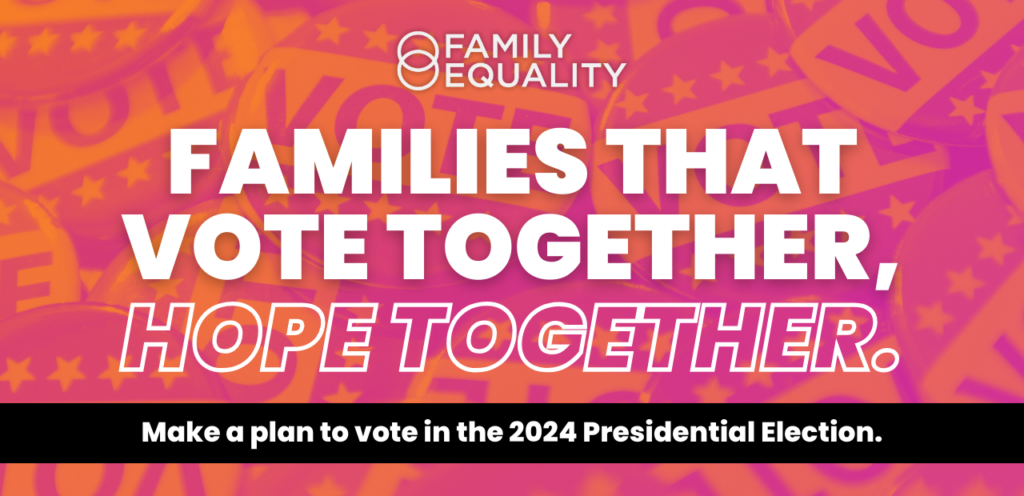
Family Equality’s mission is to create a world where everyone can experience the unconditional joy and belonging of family. That means advocating for policies, parties, and candidates that advance equality for LGBTQ+ folks and anyone who occupies identities that have been traditionally kept away from and out of power. With a pivotal presidential election upon us, it’s never been more important to ensure that your voice is heard by voting at the local, state, and national levels.
In other words, elections matter — every election, not just the presidential one.
You can make a difference in the lives of Americans, and it all starts with making a plan to vote — and then encouraging your friends and family to do the same. After all, families that vote together, hope together.
What’s at stake for the LGBTQ+ community in the 2024 Presidential Election?
Our love, family, and freedom. Family Equality doesn’t endorse any specific party or candidate. But we can look at the records of the past two administrations to better understand how and why we must elect equality champions to create a more equitable and just nation.
Make your voice heard: Create a plan to vote
New data shows that a record 75 million voters prioritize LGBTQ+ inclusive policies when making decisions at the ballot box, and research from 2022 suggests that LGBTQ+ people make up 1 in 10 voters, which is a significant percentage of the electorate. In other words, if we all get out and vote, we will make our voices heard.
The problem is that one-third of these equality voters are at risk of not voting in 2024. In 2020, 1 in 5 eligible LGBTQ+ adults weren’t registered to vote. Each election, millions of eligible voters are unable to cast their ballots because of a missed registration deadline, outdated registration information, or other problems with their voter registration. By creating a plan to vote, you won’t miss your opportunity to make your voice heard!
Check your voter registration or register to vote
If you’ve voted in elections before, take five minutes to check your voter registration status to make sure you’re still registered in your state. If you’re a first-time voter, it only takes a few minutes to register online!
While some states allow voters to register in-person on election day or during early voting, others have strict voter registration deadlines — so the sooner you register, the better!
Figure out how, where, and when you’re going to vote
Thanks to absentee, mail-in, and early voting options, there are lots of different ways to vote depending on what state you live in — do you know how you’re going to make your voice heard? Because states have different deadlines, now is the time to figure out where and how you’ll be voting.
See if your state allows absentee, mail-in, and in-person early voting. If they do, and you’re interested in pursuing these options, mark your state’s deadlines in your calendar and set a date to get voting!
Of course, you can also vote in-person on Election Day. But, that doesn’t mean you don’t have to prepare! Use the tool above to find your polling location.
Determine what’s on your ballot
Everyone’s ballot is different depending on where they live. To ensure that you’re voting for equality champions, research the candidates running for office in your area, and double-check which ballot measures will be on your ballot — and what your vote for or against them might mean.
See what’s on your ballot with Vote.org and explore ballot measures through nonpartisan educational sites like Ballotpedia.
Make voting a family affair!
At Family Equality, we believe that families who vote together, hope together. Once you’ve made a plan to vote, tell your friends and family to get in on the fun! Share this page with them, have discussions about what you discovered during your research phase, and encourage them to make a plan to vote so that everyone’s voice can be heard.
